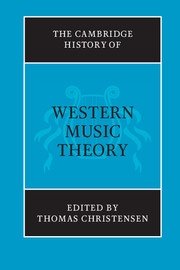Book contents
- Frontmatter
- Introduction
- PART I DISCIPLINING MUSIC THEORY
- PART II SPECULATIVE TRADITIONS
- PART III REGULATIVE TRADITIONS
- A Mapping tonal spaces
- 11 Notes, scales, and modes in the earlier Middle Ages
- 12 Renaissance modal theory: theoretical, compositional, and editorial perspectives
- 13 Tonal organization in seventeenth-century music theory
- 14 Dualist tonal space and transformation in nineteenth-century musical thought
- B Compositional Theory
- C Time
- D Tonality
- PART IV DESCRIPTIVE TRADITIONS
- Index of authors
- Index of subjects
- References
14 - Dualist tonal space and transformation in nineteenth-century musical thought
from A - Mapping tonal spaces
Published online by Cambridge University Press: 28 March 2008
- Frontmatter
- Introduction
- PART I DISCIPLINING MUSIC THEORY
- PART II SPECULATIVE TRADITIONS
- PART III REGULATIVE TRADITIONS
- A Mapping tonal spaces
- 11 Notes, scales, and modes in the earlier Middle Ages
- 12 Renaissance modal theory: theoretical, compositional, and editorial perspectives
- 13 Tonal organization in seventeenth-century music theory
- 14 Dualist tonal space and transformation in nineteenth-century musical thought
- B Compositional Theory
- C Time
- D Tonality
- PART IV DESCRIPTIVE TRADITIONS
- Index of authors
- Index of subjects
- References
Summary
Introduction: tonal systems without scales
Nineteenth-century music theory in German-speaking countries divides reasonably into two main traditions: thorough-bass styles of music theory and harmonic dualism. The approaches are usually thought of nowadays as scale-degree theory and functionalism, respectively; since the emphasis in the account here is on chord structure and chordal relations as expressions of such structure, the traditions are characterized so as to foreground these particular aspects in their approach.
Interestingly, by the last half of the nineteenth century, the two traditions had become connected to different geo-political formations in Central Europe, such that we may properly speak of thorough-bass theory as Viennese (or more generally, Austrian) and harmonic dualism as Prussian, in the sense that these approaches were developed or extended within the context and dynamic of relevant educational institutions and their corresponding research ethoi in those two areas. A third major tradition, the fundamental-bass theory emanating from the work of Rameau, was more international in scope and influence. In spite of obvious dissimilarities, it was considered by harmonic dualists (in particular, Riemann) to form an important early articulation of a number of theoretical concepts basic to their own approach, a judgment shared less positively by Heinrich Schenker, who saw Riemann’s approach to tonality as little more than warmed-over Rameau. This particular alignment of approaches seems based entirely on whether one held that the structure-forming relations within chords could withstand registral rearrangement (as both Riemann and Rameau did) or not (as asserted by thorough-bass theorists).
- Type
- Chapter
- Information
- The Cambridge History of Western Music Theory , pp. 456 - 476Publisher: Cambridge University PressPrint publication year: 2002
References
- 40
- Cited by



